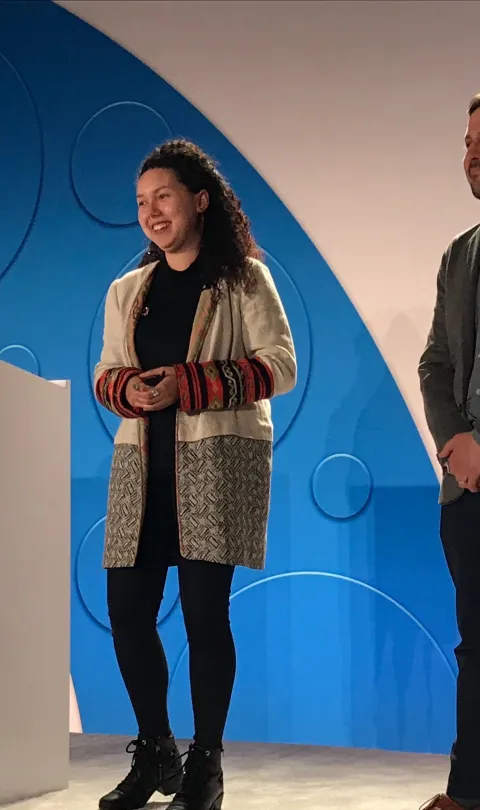“Giving the right data at the right time to people as they are making a decision becomes vital. You can have the best data in the world but if it’s not there when you are acting, it is not going to be helpful.”
Jim Sullivan, Head of the Global Sustainability Innovation Accelerator at SAP, spoke of the role of data for decision-making and social change at Google Next 2019 in San Francisco last month. At conferences like Google Next, where the focus is on the technology, it was exciting to see social impact factoring into more and more conversations.
Tracking Tuna from Ocean to Market
For example, seafood company Bumble Bee Foods is tracing the journey of yellowfin tuna from the Indonesian ocean to the table through SAP Cloud Platform Blockchain service. By scanning the barcode of the product using an app on their mobile phone, customers can see where their seafood was caught, who the fisherman is, whether the animal is endangered, and which fair trade practices were followed by the company and the community. As an added bonus, it provides recipes to prepare the tuna!
During the “Circular Economy 2030: Cloud Computing for a Sustainable Revolution” panel session, this was just one of many examples of how data and technology are powering sustainability efforts. The session provided an opportunity to hear how corporate actions are increasingly moving to support a circular economy. The Ellen MacArthur Foundation talked about how civil society actors accelerate the transition to a circular economy. Representing the Global Partnership for Sustainable Development Data, I discussed how providing multi-stakeholder spaces for collaboration can help ensure we have the right data to achieve and monitor the Sustainable Development Goals (SDGs).
It was a fascinating, important discussion, but the main reason for the session was to announce the five finalists of the Circular Economy 2030 Challenge. As a non-profit partner, the Global Partnership has been supporting the process to select high-impact social entrepreneurs contributing to SDG12: Ensure sustainable consumption and production patterns. The five selected proposals are working towards reducing and recycling e-waste, food waste, and industrial waste by connecting those creating waste and those who can process or utilize it leveraging data and technology.
SAP and Google Cloud also organized a two-day workshop for the selected social entrepreneurs to receive mentoring and coaching to refine their proposals. For example, the module I facilitated focused on advocating and achieving impact through data by asking the finalists to assess their data value chain (through a model developed by Data2X and Open Data Watch).
These entrepreneurs from Estonia, Germany, Kenya, the United Kingdom, and the United States created solutions that address specific realities in the waste value chain, but they are all tackling social issues that go beyond borders and affect us all.
When Tech Innovations Become Toxic
For example, Patrick Peter, founder of Circunomics, was traveling in Ghana when he visited Agbogbloshie, a 20-acre electronic waste dump in the heart of Accra, where about 80,000 people live, dependent upon retrieving and selling metals from e-waste. It is considered one of the most poisonous places in the world. Agbogbloshie is where the marvels of technology go to die, and it is where Patrick's interest in recycling and certifying battery components was born.
Patrick explained how seeing the ‘dark side’ of the battery economy sparked something in him. He started talking to industry experts and found a lack of information. Producers, recyclers, traders, and buyers failed to find the right partners and to establish a sustainable battery value chain. Through Circunomics, Patrick wants to leverage existing data from manufacturers to create a battery recycling market to execute at scale, providing the right data to the whole value chain.
Machine Learning and Wildlife Biodiversity
In addition to supporting social entrepreneurship, Google Cloud’s Data Solutions for Change program helps many non-profits leverage data through technology to achieve their mission. One example involves lots and lots of animal photos.
Camera traps – a digital camera with a motion sensor attached that snaps a photo whenever an animal walks by – are a common research method to monitor abundance of species and behavioral insights. The method provides useful information, but a six-month long camera trap study could generate up to half a million images that then need to be sorted and analyzed (not all images provide information, as there are a lot of ‘false positive’ photos without any animals).
The sorting process usually takes months, but with help from Google Cloud’s tools, the Zoological Society of London has been able to have non-coders use machine learning to create image-recognition models to identify species in days, not months. This information allows the Zoological Society to advocate for policy change and conservation action.
Elisse Roche, lead on Google Cloud’s Data for Social & Environmental Impact team, provided this case study at the “Data for Good: Driving Social & Environmental Impact with Big Data Solutions” session, co-hosted by the Global Partnership. I spoke about the SDGs and the importance of tackling technical and political barriers to improve data production and use. Finally, we presented the winners from our #Visualize2030 challenge, with three of the five student winners in the room.
Overall, attending Google Next and talking about the work of Global Partnership to a new audience was a wonderful opportunity. Meeting and supporting the five changemakers of the Circular Economy 2030 challenge was a highlight of the week.
My key takeaway, and recurring lesson I see throughout my work, in its make sectors and contexts, is that change is not about the data or the technology in itself, but rather about making data and innovation work for people and the planet.
